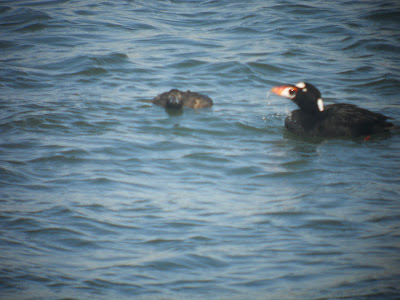This spring I've been doing field observations of the Coastal Forest Merlin (Falco columbarius suckleyi). You can find out more about this small falcon, including vocalizations and life cycle, by clicking on the link to the Merlin Falcon Foundation website. Personally, I find this little falcon to be a huge amount of kinetic energy squeezed into a small body. The Merlin's diet consists of small birds, usually caught on the wing. Its courtship, territoriality, vocalizations, and hunting are all dramatic.
Female Merlin
There is another small falcon in this region: the American Kestrel, Falco sparverius. It is the smallest of our Falconidae, but to me, the most colorful. This little guy is often seen hunting for large insects or small rodents. I have seen one eating a vole and another Kestrel catching a small Garter Snake.
Male Kestrel
We also have Peregrine Falcons, some that winter in the Skagit Valley and some that migrate thousands of miles south...as far as South America. For a few years, I helped take care of this non-releasable Peregrine at Sardis Raptor Center (See link to their website.) This particular bird was always on the alert and became excited easily.
Falco peregrinus
Audubon Print of Peregrine Falcons
Back to Merlins. The sequence of photos that follows shows two activities that are typical for this time of year: 1. preening. 2. territorial squabbles with crows.
1. Preening. This part of the breeding season, the female is testing the male to see if he is a good provider or not. She hunts less and less and waits for her mate to deliver prey items to her. She often preens, while waiting. The male and female are already mating and should start nesting and laying eggs before the end of this month. The male will hunt for his mate, his nestlings, and himself from now until the young become fledglings and disperse in late-summer.
Female Merlin Preening
The male Merlin is smaller and darker than the female. Perhaps this is why this subspecies has also been called the Black Merlin. This male, below, just attempted a prey delivery to the female. The prey exchange is extremely fast, like a hand-off in football. Sometimes, they fumble and the prey item, which took considerable energy to obtain, tumbles to the forest floor. Nobody is perfect, not even agile falcons.
Male Merlin
2. Territoriality. Merlins do not make their own nests. They reuse old corvid nests. Here in the Pacific Northwest, that means nests built by crows. Naturally, there are territorial battles between crows and Merlins. Sometimes crows, building their new nests, find that they are neighbors of Merlins, who are using old crow nests. The crows try to drive out the Merlins and the Merlins resist harassment, sometimes chasing the crows. Eventually, both crows and Merlins may stop the mutual aggression, as they concentrate on their young.
Female Merlin on a Prominent Perch
Photos taken at 300 meters
The crow attacks the female Merlin. You can see the crow's left wing, as the crow flies by.
The female Merlin looks up as the crow readies itself to dive (stoop) on her.
The crow tries to drive the Merlin off her perch.
The Crow makes another pass and the Merlin has been driven off the perch.
The female Merlin has gone into the tree and the crow is staring at her.
When the crow left, the female Merlin returned to her perch to wait for the male, who was off hunting. She endured several attacks for more than an hour, before her mate returned with food. One of the attacks was carried out by two crows, probably mates. As you can see, both Coastal Forest Merlins and Northwest Crows live their lives intensely.




























